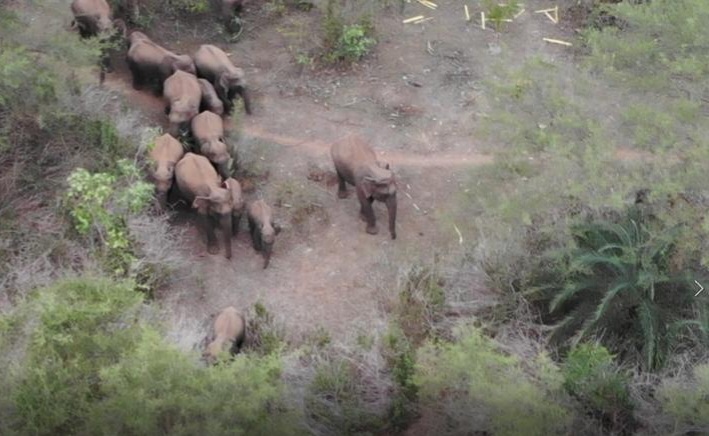
The state forest department is using drones of the Mavic 2 Enterprise series to track elephants. Many forest divisions of Odisha see acute human-elephant conflict, writes Deepanwita Gita Niyogi
Developmental activities, expansion of agricultural lands and mining are exacerbating the human-elephant conflict in India day by day. States affected by this problem are trying to find solutions to minimise damage as well as loss of lives.
While early warning systems and the deployment of Hathi Mitras (friends of elephants to track their movement) are working wonders in some parts of the country, Odisha has found the use of drones effective in conflict management.
Though conflict occurs throughout the year, the paddy harvest season is a particularly tense time. In Angul district, the presence of elephants is high during this crucial period, especially from November to February. The animals enter from Dhenkanal and Sambalpur districts. Vivek Kumar, divisional forest officer (DFO), Angul, said in such a situation drones prove to be effective.
“Drones are extensively used in agricultural fields which are open lands. There is clear visibility which helps in counting the number of animals, see the direction they are moving towards and to know if there are hindrances in their path in the form of physical barriers.”
In Angul, where there are about 200 elephants present during the harvest season, paddy cultivation has been intensified thanks to borewells. In this sensitive area, the department has been relying on three drones for the past few years. Drones with thermal imaging capabilities are useful in capturing images at night.
The drones are used once in about five days. They have 20-minutes battery back-up but even then can cover long distances. The department tries to use thermal cameras when the animals move inside forest areas. Crop damage can also be assessed with the help of drones.
Use of technology
Though the department is using drones in elephant conflict management, there is a need to train more people for frequent usage. The department is using Mavic 2 Enterprise series drones. In Dhenkanal division, three departmental staff have been trained in handling drones.

There are two parts in a drone. One is the operation part and an expert has to be in touch with the machine after flying it. The second part is analysis of the inputs of the drone. If field staff are unable to reach a particular area, drones help in observation.
Dhenkanal has resident as well as migratory elephants. The conflict here is acute. The average count is over 300 elephants throughout the year. It varies from 250 and can go up to 380 also.
There are areas devoid of forests in the district and many elephants actually don’t move inside forests. For food, they depend on crop lands, seasonal fruits of palmyra palm which ripen in June-July, cashew and mango orchards. “They have adopted the area as their habitat. There are 120 elephants in particular who depend on the ready food they always get,” said DFO Dhenkanal Prakash Chand Gogineni.
The officer explained that drones are helpful when there is no direct sighting. For instance, the Brahmani river flood plains is filled with tall grasses. If elephants are present inside, they cannot be directly sighted. But sometimes the department likes to know the situation on the ground and drones are of great help.
Are drones the answer?
Though drones are effective, they come in handy only in open areas and not closed ones. “When forest is dense there are signal issues,” said Anand S, DFO, Athamallik division in Angul district, which is not far from the SatkosiaTiger Reserve. In this division, there has always been elephant movement. But thanks to horticultural initiatives, the problem has become acute since 2000.
Angry farmers are hard to deal with in case of crop loss. From 2019 to 2022, the forest department has paid Rs 12,94,25,024 for crop damage on 12114 acres of land.
Apart from too much paddy and horticultural crops, mining is another major problem leading to conflicts. DFO, Keonjhar Dhamdhere, Dhanraj Hanumant said in his division there are iron ore and manganese mines. “Though mitigation measures are being taken, conflict has increased. In the daytime, there is patrolling but after 5 pm watching elephant movement is an issue. But drones help us see which way the animals are moving. It helps mobilise staff to locate poachers too.”
At present the major problem with drones is that the battery lasts for a limited period of time. Another thing is that if drones are brought close to elephants they get annoyed and try to move away from the sound.
Jharkhand-based DS Srivastava, who has a long experience in dealing with elephant conflict and management, said drones have become easy and sometimes now replace forest staff and Hathi Mitras. But he questioned the efficacy of drone usage even if a herd has been tracked near a village. “Fore warning is the main thing and the animals should never be chased in the wrong direction. Ground awareness about elephant behaviour still works best.”
Mining and highways are the main causes of concern when it comes to human-elephant conflict in Odisha. In the past three years, there have been 167 human deaths in just three divisions. Elephants from Jharkhand enter the state in search of habitat.
Rudra Mahapatra, project head of Wildlife Trust of India in Odisha, said drones once helped in tracking an elephant which was sleeping inside a thicket. Before that it was thought to be dead. Initially Odisha was sceptical about usage of drones but it was promoted during a project in Similipal National Park and found favour later.












